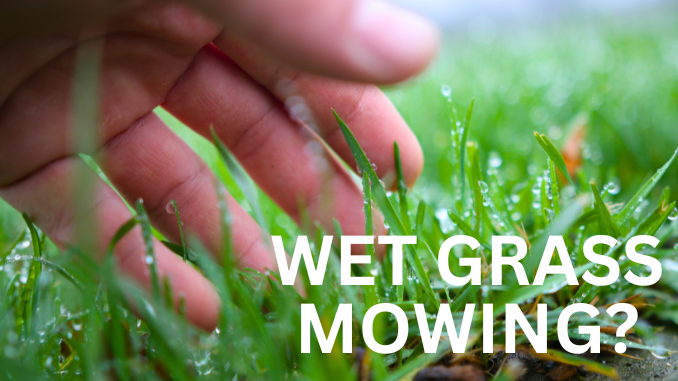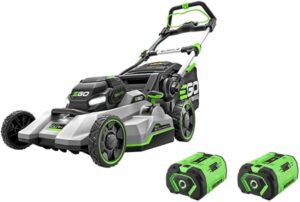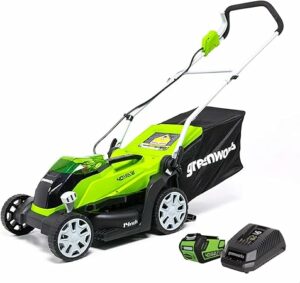
Please note: As an Amazon Associate we earn from qualifying purchases. Details here.
Can you use an electric lawn mower on a wet grass (or in the rain)?
If we cut straight to the chase then using an electric lawn mower on wet grass is like trying to vacuum your carpet during a flood.
Sure, you could do it, but should you?
Absolutely not.
While your neighbor might swear they’ve been doing it for years without issue, the risks far outweigh any perceived benefits.
Regardless of the type of machine you’re wielding, wet grass and lawn mowers simply don’t mix well.
Let’s discuss why you should always wait for dry conditions before firing up your electric mower.
Top 5 Reasons to Keep Your Electric Mower Away from Wet Grass
Alright.
Now that we’ve established wet grass and electric mowers don’t mix, let’s dive into the specific reasons why this combination spells disaster.
From mechanical mayhem to personal peril, these five compelling reasons will convince even the most impatient lawn enthusiast to wait for dry conditions.
1. Your Mower Will Work Overtime (And Not in a Good Way)
Wet grass is basically nature’s version of glue.
Those soggy blades stick together in thick clumps that your mower has to fight through like a warrior battling through quicksand.
This extra resistance forces your motor to work harder than it should, potentially leading to overheating or complete burnout.
Think of it this way: would you run a marathon wearing ankle weights? That’s essentially what you’re asking your mower to do.
2. Kiss Your Perfect Lawn Goodbye
Mowing wet grass is the quickest way to turn your lawn into something resembling a bad haircut from the ’80s.
Wet blades bend and lie flat, dodging your mower’s path only to pop back up later like stubborn cowlicks.
Usually, the result would be an uneven, patchy mess that’ll have your neighbors wondering if you let your teenager practice their barbering skills on your lawn.
3. Hello, Lawn Diseases
Creating the perfect environment for fungal growth is probably not on your weekend to-do list, but that’s exactly what happens when you leave clumps of wet grass scattered across your lawn.
These damp piles become breeding grounds for mold, bacteria, and various lawn diseases that can spread faster than gossip at a neighborhood BBQ.
Even worse, these nasty microorganisms can take up residence in your mower’s undercarriage, ready to infect your entire lawn the next time you mow.
4. The Electric Shock Factor
Here’s where electric mowers face a unique risk.
While modern electric mowers have safety features that minimize shock risks, combining electricity with water is still asking for trouble. Even with proper insulation and ground fault protection, why tempt fate?
A malfunctioning extension cord, damaged insulation, or faulty connection could turn your Saturday morning lawn care into an emergency room visit.
5. Slip, Slide, and Potentially Collide
Wet grass is slippery. Shocking revelation, right?
But when you’re pushing or pulling heavy machinery with sharp, spinning blades, that slick surface becomes a serious hazard.
According to research from Johns Hopkins University, lawn mower injuries result in over 50,000 hospitalizations over an eight-year period in the US alone.
Nearly half of these injuries are lacerations, with fractures and amputations making up most of the rest. Those aren’t odds worth gambling with.
Can You Use A Battery-Powered Lawn Mower On Wet Grass or In the Rain?

Look…
Many homeowners wonder if cordless electric mowers offer a safer alternative for cutting damp lawns.
It’s a logical question – without an extension cord trailing behind you, doesn’t that eliminate the electrical hazard?
While you’re correct that removing the cord does reduce certain risks, it doesn’t solve all problems.
Cordless mowers do have safety advantages: their electrical components are housed in sealed plastic casings isolated from both the user and the wet turf below.
Plus, the battery voltage typically isn’t high enough to pose significant shock dangers.
However, don’t be misled by these electrical safety improvements.
All the other complications associated with mowing wet grass like…
- poor cutting performance,
- clumping,
- uneven results,
- potential lawn damage,
- and increased slip hazards
… remain exactly the same whether you’re using a corded or battery-powered electric mower.
In the end, despite the reduced electrical risk, using a cordless mower on wet grass simply isn’t worth it.
If You Really Must… My Tips for Mowing Wet Grass
Every type of mower struggles with wet grass, but if you really feel like you must mow your lawn when it is wet then try and follow these guidelines:
- Use a mower that bags or side discharges
This will reduce the levels of wet grass being recycled in your mower.
- Mow in the evening
This should give the best chance for your wet lawn to dry out with some help from the sun (hopefully!).
- Raise the blade height
Set the cutting height of your mower to be at least 35mm and make narrower passes.
- Check your lawn for drainage issues
If your grass seems perpetually wet, there could be underlying issues affecting it.
And if you’re looking for some new electric mowers to consider, below you’ll find a quick top 3 list.
Top 3 Electric Lawn Mowers for 2025 (For When Your Grass is Actually Dry)
Speaking of taking care of your equipment, investing in a quality electric mower is the first step toward maintaining a beautiful lawn.
These three models stand out in 2025 for their reliability, performance, and safety features but just remember to use them only on dry grass!
1. EGO Power+ LM2156SP 21-Inch Select Cut Mower
This self-propelled beast offers variable speed control and delivers the power of gas without the fumes.
Its weather-resistant construction means it can handle morning dew (though still wait for dry conditions), and the LED headlights let you mow at dusk when grass is typically driest.
Also, with its Select Cut multi-blade system, you get a cleaner, more customized cut every time.
2. Greenworks 40V 14-Inch Cordless Mower
The Greenworks 40V 14-Inch Cordless Mower is one of the top electric mowers thanks to its lightweight design, making it easy to maneuver even in tight spaces.
Powered by a 40V lithium-ion battery, it runs clean and quiet with zero emissions, perfect for eco-conscious homeowners.
Its 2-in-1 system allows for both mulching and rear bagging, giving users flexibility in lawn care.
With a push-button start, adjustable cutting height, and foldable handle, it’s built for convenience and storage in smaller spaces.
3. Sun Joe MJ401E-P2 14-Inch Electric Mower
The Sun Joe MJ401E-P2 14-Inch Electric Mower is a top pick for small lawns due to its compact design and powerful 12-amp motor, which efficiently cuts a 14-inch wide path.
Its lightweight build and rugged all-terrain wheels make it easy to maneuver in tight spaces, while the 3-position manual height control allows for precise cutting adjustments between 1.18 and 2.52 inches.
The mower features a 10.6-gallon hard-top rear bag for convenient grass clipping collection and a collapsible handle for compact storage.
Maintenance-free operation, that is no gas, oil, or tune-ups required which adds to its user-friendly appeal, making it an excellent choice for eco-conscious homeowners.
Next, let’s move on to the frequently asked questions.
FAQs About Electric Lawn Mowers on Wet Grass
Still have questions about when it’s safe to mow?
You’re not alone.
Here are the most common concerns homeowners have about electric mowers and wet conditions, along with straightforward answers to keep you and your lawn safe.
Q: What if I absolutely must mow and the grass is slightly damp?
If you’re in a genuine bind, wait until evening when dew has had maximum time to evaporate. Raise your cutting height, make narrower passes, and clean your mower thoroughly afterward. But honestly? Just wait another day.
Q: Are battery-powered mowers safer on wet grass than corded ones?
While battery mowers eliminate the risk of cutting through a wet extension cord, they’re still not safe on wet grass. The slip hazards, poor cut quality, and mechanical strain remain the same.
Q: How long should I wait after rain to mow?
Generally, wait at least 24-48 hours after rain, depending on sun exposure and humidity. The grass should feel dry to touch, and you shouldn’t see water droplets when you walk through it.
Q: Will mowing wet grass void my mower’s warranty?
Many manufacturers specifically warn against using their mowers on wet grass. Check your warranty terms; operating outside recommended conditions could indeed void your coverage.
Q: What about morning dew, is that considered “wet”?
Yes! Heavy morning dew counts as wet conditions. Wait until mid-morning or later when the sun has dried things out.
Can You Use An Electric Lawn Mower On Wet Grass? (The Bottom Line)
Look…
After exploring all these risks and recommendations, the message is crystal clear.
Patience pays off when it comes to lawn care.
Whether you’re using a top-of-the-line mower or a budget model, the rules remain the same: dry grass only.
Your electric lawn mower is designed to last and give you years of reliable service, but only if you treat it right.
Mowing wet grass is like feeding your car sugar instead of gas; it might work briefly, but you’re asking for expensive problems down the road.
Next time you’re tempted to tackle that soggy lawn, remember that patience isn’t just a virtue, it’s a money-saver, a safety measure, and the secret to a lawn that actually looks good.
Your mower, your grass, and your medical insurance will all thank you for waiting.
Now, I’d like to hear from you:
Did you use an electric mower on wet grass or in the rain before? If yes, what’s been your experience?
Share your thoughts in the comments below!

Be the first to comment